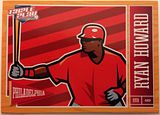A Jim Palmer was a great pack pull in the 1970s. He won 20 or more games eight out of ten years in the 1970s. Jim won three AL Cy Young Awards and finished second in two other seasons. Palmer pitched for the Baltimore Orioles from 1965-1984 and was elected to the Hall of Fame in 1990.
Palmer was signed by the Baltimore Orioles in 1963. Palmer's career almost ended before it started when he was involved in an automobile accident near Kayenta, AZ (on the Navajo reservation) on August 16, 1963 (May 1990 Baseball Digest). He was 11-3 with a 2.51 ERA for Class A Aberdeen in 1964 and that earned him a shot at the Orioles in 1965. Jim was a swingman in 1965 and was 5-4 with a 3.72 ERA in 27 games (6 starts).
Jim became a regular member of the Baltimore rotation in 1966. He started 30 games and was 15-10 with a 3.46 ERA. Palmer started game 2 of the 1966 World Series and beat Sandy Koufax by pitching a 4-hit shutout.
In 1967 Jim started with the Orioles but was injured and missed several months of the season. He ended up 3-1 with a 2.94 ERA in nine starts. Palmer didn't pitch for the Orioles at all in 1968 but he did do some pitching in the minors. He felt some muscles ripping in his back one day in 1968 while pitching in the minors and went back to Baltimore for some tests. Jim had surgery, went on a weight program and was able to rehabilitate himself.
Palmer came back in 1969 to lead the AL with a .800 winning percentage. Jim was 16-4 with a 2.34 ERA in 23 starts. He had a shot at winning 20 games but he was injured (unrelated to his arm) and missed six weeks. Jim pitched a no-hitter against the Oakland Athletics on August 13. Palmer started and won game 3 of the ALCS. He took the loss in game 3 of the World Series.
Jim made his first AL All Star team in 1970. He started the game and pitched three scoreless innings. Palmer went 20-10 with a 2.71 ERA and led the AL with five shutouts and 305 innings pitched. Palmer won game 3 of the ALCS. He started twice in the World Series and was the winning pitcher in game 1.
Palmer pitched two scoreless innings in the 1971 All Star Game. He was 20-9 with a 2.68 ERA, won game 3 of the ALCS, and won game 2 of the World Series. He started game 6 of the World Series and left the game after nine innings with the score tied 2-2 (Baltimore won the game in 10 innings).
Jim went 21-10 with a 2.07 ERA in 1972. He started the All Star Game and pitched three scoreless innings. In 1973 Palmer won his first AL Cy Young Award and finished second to Reggie Jackson in MVP voting. Jim went 22-9 with a league-leading 2.40 ERA. In the 1973 ALCS Palmer pitched a 5-hit shutout in game 1. He started game 4 but got knocked out in the second inning after allowing three runs. Jim entered game 5 in the fourth inning and shut the A's out over 4 1/3 innings but the damage was done as Oakand won the game and the series. A side note: it's hard to believe that only 24,265 fans attended that deciding game in Oakland. Jim Palmer Views The Pinch Hitting Rule - May 1973 Baseball Digest.
Palmer missed two months of the 1974 season with elbow problems. He went 7-12 and had a 3.27 ERA in 26 starts. Jim started game 3 of the ALCS and allowed only one run (a Sal Bando solo home run) on four hits in nine innings, but Vida Blue pitched a shutout and Palmer was tagged with his only career League Championship Series loss.
Jim came back to pitch very well in the next three seasons. He led the AL in wins in 1975, 1976, and 1977. Palmer won the AL Cy Young Award in '75 and '76 and was the runner up in 1977. Palmer was 23-11 with an AL-leading 2.09 ERA in 1975. In 1976 he was 22-13 with a 2.51 ERA. Jim Palmer: The Orioles' Pitching Symphony - January 1977 Baseball Digest. Jim went 20-11 with a 2.91 ERA in 1977. Palmer also won four straight Gold Gloves from 1976-1979. How Jim Palmer Sizes up His Pitching - June 1977 Baseball Digest.
Jim didn't lead the AL in wins in 1978 (Ron Guidry had his great 25-win season that year) but still pitched well. He was 21-12 with a 2.46 ERA and was third in Cy Young Award voting. Palmer was hurt in 1979 and missed six weeks from early July to mid August. He ended up 10-6 with a 3.30 ERA in 23 starts. Jim started game 1 of the ALCS and left the game after nine innings with the score tied 3-3. The Orioles won that game in ten innings. He started game 2 (no decision) and game 6 (a loss) of the 1979 World Series.
Palmer's ERA shot up to 3.98 in 1980 but he still had a good 16-10 record in 33 starts. Jim was 7-8 with a 3.75 ERA in 22 starts in 1981.
Jim's last big year was 1982. He went 15-5 and led the AL with a .750 winning percentage. Palmer finished second to Pete Vuckovich in AL Cy Young Award balloting during a year in which nobody would win more than 18 games.
Jim made two trips to the disabled list in 1983, missing a total of about 3 1/2 months. He was 5-4 with a 4.23 ERA in 11 starts in 1983. Palmer wasn't used in the 1983 ALCS, but he pitched two innings in relief in game 3 of the World Series and earned the win.
Palmer's last year was 1984. He was 0-3 with a 9.17 ERA when he was released on May 12, 1984.News story about Palmer's release:
After his playing career Palmer became a broadcaster. He was already doing postseason games for ABC during seasons when the Orioles weren't in the playoffs. Jim is now broadcasting for the Orioles.
Jim attempted a comeback in 1991, a year after he was elected to the Hall of Fame. The comeback lasted for a few weeks in spring training.
Jim seems to be the calm one out of the three pitchers interviewed for this article about baseball's unwritten rules.
Liked to face: Barry Bonnell (.000 in 15 AB); Jamie Quirk (.045 in 22 AB); John Ellis (.056 in 36 AB)
Hated to face: Al Oliver (.478 in 23 AB); Rickey Henderson (.476 in 21 AB); Rod Carew (.358 in 95 AB)
Thursday, May 27, 2010
1976 Topps #450 - Jim Palmer
Subscribe to:
Post Comments (Atom)







.jpg)































































































Heck of a uniform on Mr. Palmer! Not many teams would feature that shade of...red...purple...salmon? It's definitely a color. Did you pull that very card in your youth?
ReplyDeleteJudging from the corner ding on the bottom right, that was probably one of the original cards from when I was 9 years old. Gotta love those 70s colors! :)
ReplyDelete